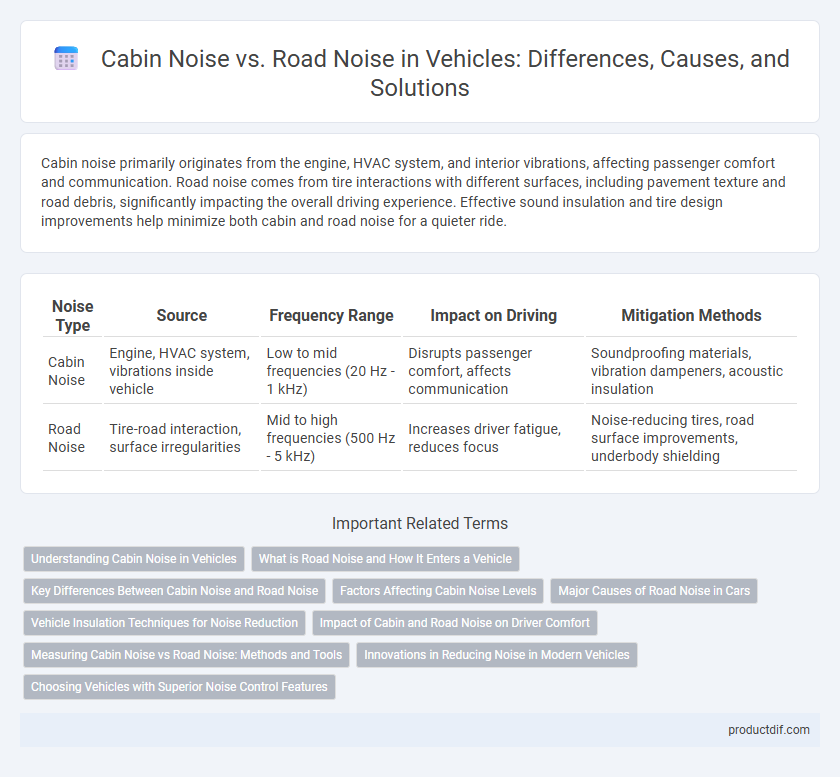Cabin noise primarily originates from the engine, HVAC system, and interior vibrations, affecting passenger comfort and communication. Road noise comes from tire interactions with different surfaces, including pavement texture and road debris, significantly impacting the overall driving experience. Effective sound insulation and tire design improvements help minimize both cabin and road noise for a quieter ride.
Table of Comparison
| Noise Type | Source | Frequency Range | Impact on Driving | Mitigation Methods |
|---|---|---|---|---|
| Cabin Noise | Engine, HVAC system, vibrations inside vehicle | Low to mid frequencies (20 Hz - 1 kHz) | Disrupts passenger comfort, affects communication | Soundproofing materials, vibration dampeners, acoustic insulation |
| Road Noise | Tire-road interaction, surface irregularities | Mid to high frequencies (500 Hz - 5 kHz) | Increases driver fatigue, reduces focus | Noise-reducing tires, road surface improvements, underbody shielding |
Understanding Cabin Noise in Vehicles
Cabin noise in vehicles primarily originates from engine vibrations, aerodynamic drag, and sound insulation materials within the cabin. Effective noise reduction requires analyzing the frequency range of engine noise, road surface interaction, and structural resonance inside the vehicle interior. Advanced acoustic engineering and soundproofing technologies significantly enhance passenger comfort by minimizing intrusive cabin noise levels.
What is Road Noise and How It Enters a Vehicle
Road noise refers to the sound generated by the interaction between a vehicle's tires and the road surface, including vibrations transmitted through the chassis. It enters the vehicle cabin primarily through the tires, suspension components, and the body panels, often amplified by poor insulation or gaps in door seals and windows. Effective acoustic insulation and advanced materials can significantly reduce the intrusion of road noise, enhancing overall cabin comfort.
Key Differences Between Cabin Noise and Road Noise
Cabin noise refers to the sounds experienced inside the vehicle's interior, primarily influenced by engine operation, HVAC systems, and audio devices, whereas road noise originates from tire interactions with the pavement, including surface texture and debris impact. Key differences include cabin noise being more consistent and controllable through insulation and design, while road noise varies with road conditions and tire types, often requiring specialized sound-deadening materials and tire engineering. Understanding these distinctions is crucial for automotive engineers aiming to enhance passenger comfort through targeted noise reduction strategies.
Factors Affecting Cabin Noise Levels
Cabin noise levels are primarily influenced by road surface conditions, tire type, and vehicle speed, which directly impact the intensity of road noise transmitted into the cabin. Engine vibrations, aerodynamic design, and insulation materials also play critical roles in modulating overall cabin noise. Advanced soundproofing technologies and specialized acoustic glass help reduce the intrusion of external noises, improving in-cabin comfort.
Major Causes of Road Noise in Cars
Road noise in cars primarily originates from tire-road interaction, where the texture of the pavement and tire tread design significantly influence sound levels. Wind turbulence around side mirrors and window seals also contributes to road noise, especially at higher speeds. Engine vibration transmitted through the chassis can amplify road noise, affecting overall cabin acoustic comfort.
Vehicle Insulation Techniques for Noise Reduction
Vehicle insulation techniques significantly reduce cabin noise and road noise by incorporating multi-layered soundproofing materials such as mass-loaded vinyl, foam, and acoustic barriers. Advanced door seals and double-glazed windows further minimize external noise infiltration, enhancing passenger comfort. Strategic placement of insulation within the vehicle chassis and floor pan effectively mitigates vibrations and air-borne noise from road surfaces.
Impact of Cabin and Road Noise on Driver Comfort
Cabin noise significantly affects driver comfort by influencing concentration and increasing fatigue during long drives. Road noise, primarily caused by tire-road interaction and surface irregularities, penetrates the vehicle interior and can lead to higher stress levels and reduced communication clarity. Effective sound insulation and advanced noise cancellation technologies are essential in minimizing both cabin and road noise to enhance overall driving experience.
Measuring Cabin Noise vs Road Noise: Methods and Tools
Measuring cabin noise and road noise involves distinct methodologies using specialized tools such as sound level meters, accelerometers, and frequency analyzers. Cabin noise is typically assessed inside the vehicle using microphones positioned at the driver's and passengers' ear levels to capture real-time acoustic data. Road noise measurement relies on external sensors mounted near the tires or chassis combined with vibration sensors to analyze tire-road interaction and surface texture effects.
Innovations in Reducing Noise in Modern Vehicles
Modern vehicles utilize advanced soundproofing materials and active noise cancellation technology to significantly reduce cabin noise, enhancing passenger comfort. Innovations such as acoustic glass, optimized door seals, and vibration-damping engine mounts minimize intrusion of road noise and engine vibrations. Integration of smart noise-adaptive systems further tailors noise reduction depending on driving conditions, contributing to quieter and more serene cabin environments.
Choosing Vehicles with Superior Noise Control Features
Choosing vehicles with advanced noise control features enhances cabin comfort by effectively reducing both cabin noise and road noise. Key technologies include acoustic laminated glass, specialized sound-deadening materials, and active noise cancellation systems that target low-frequency road vibrations. Prioritizing models equipped with these innovations ensures a quieter driving experience and improved overall vehicle refinement.
Cabin Noise vs Road Noise Infographic

 productdif.com
productdif.com